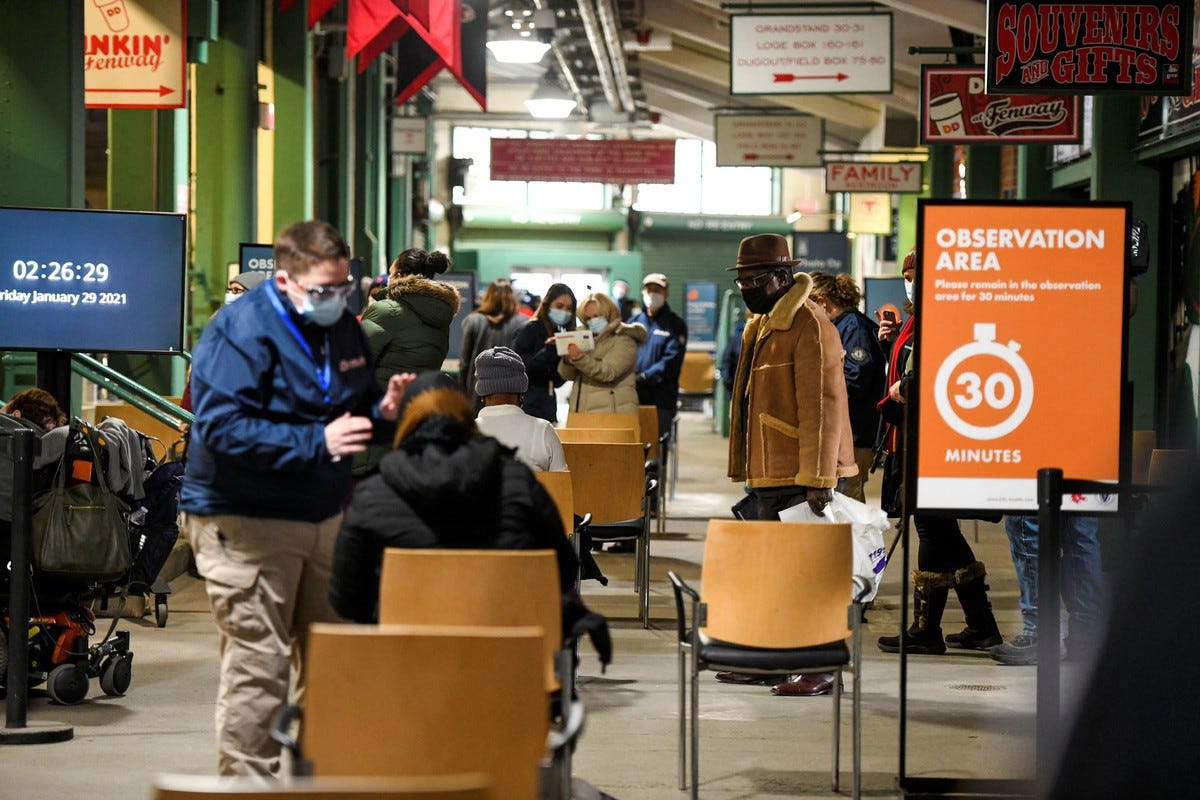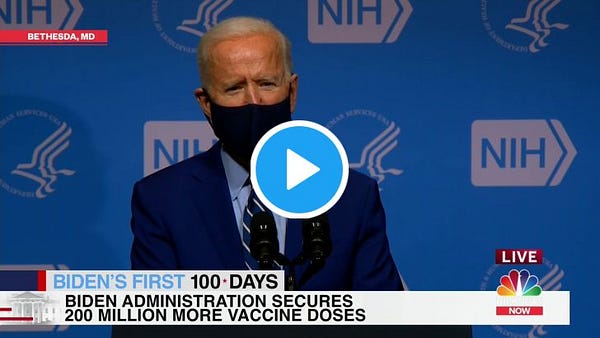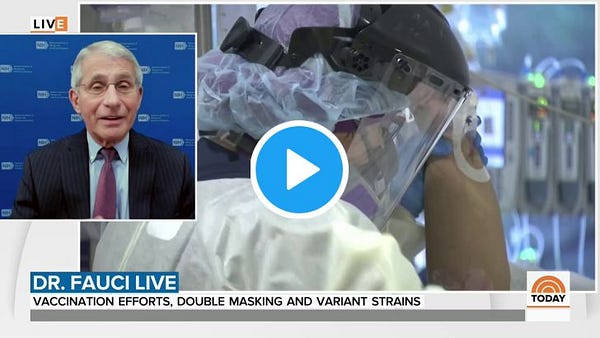Issue 46: Coming Off The Covid Clock
2.13.21 | The pandemic will end as it began -- for each of us at a different time
Hello,
This week the horizons of the pandemic widened in two directions at once. A consensus seems to be forming that, because of the virus’s ongoing mutations, we’ll never reach herd immunity even with vaccines, and so while SARS-CoV-2 can be tamed into a nuisance instead of a prolific killer it will likely never be eradicated.
We got anchored into the idea of eradication at the outset of the pandemic, as experts recalled the experience of SARS in the early 2000s. In that case, an emerging infectious disease really was identified, understood, contained and wiped out. That’s the technocratic ideal — but more often novel pathogens escape our containment and simmer indefinitely, like HIV, Ebola, or MERS.
Also this week a WHO mission announced it found evidence supporting a hypothesis that SARS-CoV-2 had begun to quietly circulate in China as early as October 2020, months before the outbreak in Wuhan.
In other words the clock started ticking on Covid earlier than we thought, and it will go on ticking longer than we guessed. The question is, when will you stop hearing it?
Back in March of last year I wrote about how the pandemic was becoming real for people at different times. In my research interviews, the pattern was that the pandemic became real for people when it started warping parts of the world they knew best — when friends or colleagues or colleagues overseas got sick or quarantined, or when trips abroad for work or pleasure got cancelled because of the virus; closer to home, when their school or office shut down, when events they cared about were cancelled, when someone they knew was diagnosed, or otherwise when the virus started causing chaos in a field where they had expertise.
For some people of course the pandemic has never become real. Indeed for some of these folks a lot rides on it not being real, and a media ecosystem works diligently to keep that reality at bay, like the East German family in Good Bye, Lenin! frantically trying to keep their ailing mother from learning communism has collapsed1.
But most of us have been on the Covid clock for 11 months or longer by now. Some have started planning out their Covid-versaries, if they can pinpoint the day they became full-on Pandemic People (for me it was March 12th). And at this point some people are already starting to come off the clock. Maybe they’ve been vaccinated and have decided (incorrectly) that now the risk of Covid for them, personally, is over, and so the pandemic is over. Maybe these are the people New York Governor Andrew Cuomo is catering to by prematurely reopening indoor dining and allowing wedding receptions with up to 150 guests—a move one virologist called “completely reckless” because of the still-massive numbers of people with Covid who are currently infectious, combined with the threat posed by the more easily transmissible variants, and that thanks to moves like Cuomo’s it’s not “hyperbolic to say the worst could be yet to come.”
And yet! It looks like a majority of Americans could be vaccinated in three or four months, and the vaccines so far have been extremely effective in keeping people who contract Covid from becoming sick enough to be hospitalized or die, even if they catch one of the new variants. Mass vaccination will arrive at a time when seasonality effects will already be driving down transmission.
So by summer, more and more of us are likely to feel safe coming out of quarantine and putting the acute phase of the pandemic behind us. It will happen unevenly across families and friend groups, and there will be awkward negotiations around how to politely turn down invitations to a birthday party or wedding or someone’s open-mic night, how not to take it personally when someone you know isn’t ready to hug or to meet inside for a happy hour. There will be new tensions around work. Already, workers are uneasy about pandemic safety: with employers who want them back on site even if they don’t think it’s safe. That’s especially true for workers who have to deal with members of the public who may be unable or unwilling to take safety seriously. Frontline workers have been dealing with this from the start, but expect those tensions to filter into all kinds of professions.
That’s before we even talk about the millions of people, most of them women and people of color, who have been either pushed out of the workforce altogether or who have had their careers stunted by working conditions under the pandemic. How will they re-engage? What kinds of opportunities will even be available in the post-pandemic economy?
There’s a real danger that the people and institutions that emerge from the pandemic with the least damage will decide that it’s time to move on into the Roaring 20s, and leave unaddressed the yawning inequalities that have been exacerbated by the crisis. Without very deliberate action to keep attention focused on long-term pandemic relief, the urgency around an equitable, broad-based recovery will fade. That’s the worst case scenario — that we’ll have gone through a year of chaos that killed half a million or more Americans, and the biggest social-structural change on the other side would be that $1 trillion in wealth will have been siphoned upwards into the accounts of the nation’s 660 billionaires while more than 8 million people fell into poverty.
This pandemic will recede as unevenly as it arrived. Its unequally distributed consequences will last for as long as we fail to address them. There will be the health consequences — long-term disability for people who suffered severe infections, developmental issues for children who were in utero during the pandemic, substance abuse issues worsened by isolation — but there will be social and economic consequences too. Preparing to meet the challenges of an equitable recovery from this pandemic will be just as important as preparing for the onset of the next one.

// Link Roundup
Vaccinated by summer? Since inauguration the new administration has made a point of setting modest, attainable vaccine goals, and then surpassing them. First the goal was to vaccinate 1 million people a day. Then, once that benchmark was hit they moved the mark to 1.5 million a day, a 7-day average we hit this week. So there’s a track record to be confident in—when this White House promises something about vaccines, it delivers. This week President Biden announced the U.S. had purchased an additional 200 million doses of Covid vaccine from Pfizer and Moderna and pushed up the delivery date, meaning that there should be enough supply in the country to fully vaccinate 300 million Americans by the end of July. In an interview on the Today show, Anthony Fauci said based on projections he thinks that by April, vaccination appointments should be available for anyone who wants one. There will be logistical hurdles to cross distributing the vaccine, and hesitancy to overcome in order to get people to sign up for inoculation, but we are well on our way to having most of the country vaccinated by the end of the summer, in advance of what could be a resurgence of the virus in the fall.
How to protect yourself with masks: Properly fitted masks can reduce transmission of SARS-CoV-2 by more than 96 percent, a CDC laboratory study concluded this week. To reach that maximum effect, both people in a two-person interaction need to be wearing masks. But what’s a proper fit? The CDC recommends either wearing a cloth mask over a surgical mask, wearing a mask brace, or knotting the ear loops on a surgical mask (see the video below). A properly fitted mask should pull in slightly when you inhale and puff out slightly when you breathe out. It is not recommended to layer surgical masks on top of each other, or to layer cloth masks on top of N95 masks. Again, mask-wearing is more effective the more people in a given space are masked. The folks you see with masks below their noses aren’t just foolish-looking and putting themselves at risk, they’re undermining everyone else’s safety too.
— “Maximizing Fit for Cloth and Medical Procedure Masks to Improve Performance and Reduce SARS-CoV-2 Transmission and Exposure, 2021.” John T Brooks et al, CDC WMMR.
— “Improve How Your Mask Protects You.” CDC.
— “The CDC Says Tight-Fit Masks or Double Masking Increases Protection.” Roni Caryn Rabin and Sheryl Gay Stolberg, The New York Times.
— “How To Double Mask.” Boone Ashworth, Wired.
— “Why Don’t We Have An Ideal Mask Yet?” Katherine Ellen Foley, Quartz.Few serious allergic reactions to the vaccines: Between December 14 and January 18 about 17.5 million doses of Covid vaccine were administered in the U.S. From these just 66 cases of serious allergic reaction were reported, all but one of them within 11 minutes after injection. No deaths were reported. Between 77 percent (Pfizer) and 84 percent (Moderna) of these people had self-reported histories of allergy.
— “Reports of Anaphylaxis After Receipt of mRNA COVID-19 Vaccines in the US—December 14, 2020-January 18, 2021.” Tom T. Shimabukuro et al, JAMA.The missing Americans: You may have seen a provocative claim from a Lancet report condemning the Trump administration’s handling of the pandemic and estimating that 40 percent of U.S. pandemic deaths were preventable. It’s more complicated than that. Yes, the U.S. suffered 40 percent more deaths from Covid, as a share of its population, than did comparable countries in the G7, which the report shows. But the point is that since the mid 80s the U.S. has routinely had higher mortality compared to its peer countries in the G7. Even before the pandemic, average life expectancy in the U.S. lagged the other G7 countries by more than 3 years. The report concludes that, in 2018 alone, there were more than 400,000 Americans who would be alive if Americans lived as long as their counterparts in other industrialized countries.
— “Public Policy And Health In The Trump Era.” Steffie Woolhandler et al, The Lancet.
— “US Could Have Averted 40% of Covid Deaths, Says Panel Examining Trump's Policies.” Amanda Holpuch, The Guardian.Opportunities for other infectious diseases: By 2018, around the globe we had fought Tuberculosis, HIV, and Malaria to their lowest levels of sickness and death on record. The Covid-19 pandemic and the disruptions it has caused have reversed those gains.
— “‘The Biggest Monster’ Is Spreading. And It’s Not the Coronavirus.” Apoorva Mandivili, The New York Times.The pandemic is interrupting grief: I want to draw your attention to two deeply moving essays this week on the subject of how we’re dealing with grief from loss under the pandemic, at a time when most funerals are held remotely. Jude Wanga writes about the experience of being able to attend his father’s funeral only through a pixelated and jumpy video feed: “Post traumatic stress disorder occurs when the brain can’t process a traumatic event into memory. Rather than fading with time, it remains current and live. Think of a record playing. When it’s running as it should, a song finishes and the needle plays to the next song and on to the end of the record. With PTSD, the needle is stuck, skipping and scratching, the song unable to finish.” David Perry points out that there have been 3 million deaths from all causes in the U.S. in the past year, most of them not Covid-related, but the conditions of the pandemic have warped the rituals of grieving around all of them.
— “Grief, Interrupted.” Jude Wanga, London Review of Books.
— “America Isn't Ready for the Coming Wave of Grief.” Dave Perry, CNN.Why we need offices: Universal work from home is great, for employers, because it shifts almost all the costs of maintaining a physical workspace off of their balance sheets and obliges employees to pay them instead. But there’s a social cost to the organization: we lose all the special forces of space and place that bind people together, make them creative, channel their emotions, produce a collective effervescence among the staff. It’s why one of my most deeply held hypotheses about the post-pandemic economy is that physical offices will become something dominant firms will use to further disadvantage less-wealthy rivals, who will be forced to cost-cut their way to remote workforces. Anyway, Paul Ford writes beautifully about the human geography of offices, and it’s one of the best things you’ll read all week.
— “The Secret, Essential Geography of the Office.” Paul Ford, Wired.
That’s it for this week! Include a link to the newsletter in your Valentine’s Day cards. I’ll see you in the inbox next Saturday, with a look at the problem of school reopening.
A less generous reading is that a major strain of Covid denial probably has more in common with Lost Cause revisionism — that it’s part of an American stab-in-the-back mythology complex that sees the pandemic as one in a series of secret betrayals that unjustly brought down Donald Trump.






